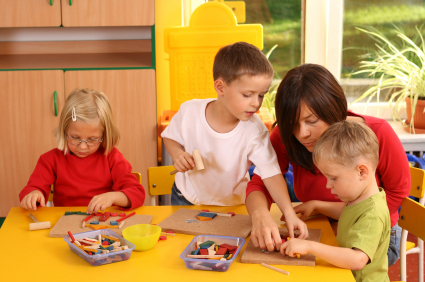 Planning Guide for Early Child Care Environments
Planning Guide for Early Child Care Environments
Laura M. Thurman and Karen B. DeBord
Department of Human Development and Family Studies
University of Missouri-Columbia
When planning learning for young children, there are several ideas to consider. First, it is especially important to provide activities, projects and themes suited to the age and individual needs of each child. Second, carefully think about each of the following elements while planning.
- Age appropriateness. Consider the ages of the children in the program. A single age group (all 4-year-olds, for example) has different needs from a mixed age group of preschoolers. The curriculum should be suitable for the developmental level of each age group and should offer a range of activities. Set group goals after assessing the needs of a particular age group.
- Individual appropriateness. Think about each individual child and focus on his or her development. Children follow similar growth patterns, but the time frame for each child differs. Individual interests, abilities and family background must be understood before you can meet the needs of each child. Goals and objectives should be set for each child.
- Family and culture. Children should not be separated from their family and culture. Plan activities with respect for family differences and wishes. Involve families in program planning as much as possible, realizing that each family has a different way of contributing. Some families may choose to be very involved, and some may choose not to.
- Teacher values. Consider what you as a teacher and caregiver believe to be important. Question your own interests, your personal philosophy and the program philosophy.
- Transitions. A variety of factors such as the length of the day or the daily schedule affect planning. Transitions are times that occur between activities and can disrupt the flow of play. Avoid too many transitions, and give children enough time to become absorbed in their play. A skillful teacher plans carefully to ensure that transition times are smooth.
- Curriculum. After preliminary planning, it is time to choose (or to help the children and/or parents choose) themes, projects and activities to build the total curriculum. Themes are selected that relate closely to the child’s immediate world. For example, activities associated with home, family, yards and neighborhoods hold the most meaning for the youngest child. As children develop, their knowledge base and interests expand. In this same way, new or additional information can be added to the curriculum.
- Themes can be used for a brief time (for example, “St. Patrick’s Day”), but usually should last at least a week. One theme will usually lead to another; for example, “dinosaurs” may lead the children’s interests to “bones,” “fossils” or “creatures.” The teacher’s role in planning themes is to observe closely and take notes on the children’s interests. Interests are determined by observing and listening to the children’s discussions and play. Play cues can aid the teacher in choosing new topics. Teachers help children develop interests through planning and presenting a variety of materials, including books, pictures, activities and explorative projects.
- Group or individual projects may be ongoing or brief. They can be very child directed mixed with teacher selected. Allowing the child to set the pace and the path of exploration will lead to new ideas and experiences. Projects can be as simple as “mud pies,” or as complex as “cameras” and “photography.”
- Activities are specific strategies planned to achieve theme and developmental goals. Making volcanoes, water color painting or scarf dancing are activities. Activities are supported by materials available in the learning centers. Activities may be repeated or may be one-time occasions.
- Group time. Planning individual times and group times is important. Individual or alone times can be provided by free choice in activities, a quiet area and rest time. Children coming together as a group, is often called “group time” or “circle time.” The whole group or a few smaller groups may be formed. During these planned times, all areas of development may be addressed in a social setting.
Songs, finger plays, dramatics, science, math and physical activities can be used during group time. Begin with simple songs and finger plays with groups of children. More complex group activities will be planned as more familiarity with the group occurs. Group times should fit into the whole curriculum and support themes and projects. Plan group opportunities for inside and outside, and for loud and quiet activities.
When you are planning specific activities, remember to include the development of the whole child. A single activity may involve several aspects of development (thinking, feeling, moving). Teachers must plan for learning to occur in all facets of the child’s development.
